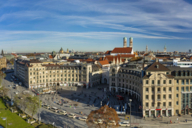
Numerous Munich stories can be told along the roughly one-kilometer-long route which starts at Karlsplatz-Stachus, continues through the pedestrian mall along Neuhauserstraße and Kaufingerstraße until it reaches Marienplatz square.
Salt traders and merchants once bustled around here. Now this area attracts countless shopping fans. Even Napoleon followed this path into Munich on a foggy evening in the fall of 1805. The double name Karlsplatz-Stachus already brings a smile to one’s face today: After taking over the rule of Bavaria in 1777 the Palatinate Elector Karl Theodor without further ado renamed squares and places in Munich after himself. This resulted in the terms Karlstor and Karlsplatz.
Munich locals engaged in civil disobedience and furnished the square with the nickname “Stachus” inspired by the nearby inn of Eustachius Föderl. The unpopular Elector had intended to trade Bavaria as a barter object to the Austrians! And so it happened that the name “Stachus” has been preserved – alongside the official term – to the present day and is even used to announce the subway stop.
The Karlstor is one of the three remaining original gates of the city wall that was torn down at the end of the 18th century. Until the construction of the pedestrian mall in 1972 this was one of the main thoroughfares of the city. Under the curved section of the arch the corners are adorned withso-called “collar heads” of prominent Munich residents. One of them depicts the coachman Franz Xaver Krenkl, whose audacity put the tolerance of King Ludwig I to a grueling test.
Munich locals engaged in civil disobedience and furnished the square with the nickname “Stachus” inspired by the nearby inn of Eustachius Föderl.
Krenkl bypassed the royal coach with a team of horses whose splendor and strength was far superior to those of the King. As if this breach of etiquette was not already too much, Krenkl called out proudly to the already-insulted sovereign, “Wer ko, der ko!” (Those who can, do!). In Bavaria this proverbial phrase has become synonymous with relaxed self-confidence.
On the way through the pedestrian mall you see the green building complex of the Munichpolice headquarters to the left on Ettstraße. Many people know this structure from the Munich “Tatort” TV series.The headquarters accommodate the Polizeimuseum which is open to the public. The exhibition documents police work, including spectacular police operations e.g. during the murderous attacks at the 1972 Olympics and criminal cases such as the murder of the Munich fashion czar Rudolph Moshammer in 2005. Advance registration at www.muenchnerblaulicht.de, Phone +49 89 29 10 20 10. Children under 14 years are not admitted.
In 1935 the devilish pilot Ernst Udet roared his plane between the two towers by flying sideways.
A few steps farther on the left you get a view of Frauenkirche which was built by Jörg von Halsbach in the 15th century. The towers with the so-called “Welsh domes” are a landmark of the city. It is less known that the domes were designed according to the Dome of the Rock in Jerusalem, one of the most important sanctuaries of Islam. The twin towers time and again inspire spectacular feats.
In 1935 the devilish pilot Ernst Udet roared his plane between the two towers by flying sideways. In 2014 a large-scale police operation was required to stop extreme climbers who had already mounted the southern tower up to the belfry. After extensive renovation work, the southern tower can be visited again. Tickets for the ascent to the observation deck can be bought here.
Now we are arriving at Marienplatz. At the time of Munich’s foundation in 1158 the whole settlement was not much larger than this square. St. Mary’s Column (Mariensäule) in the middle of the square gave the former market place its name. It dates back to an oath taken during the Thirty Years War when Munich was occupied but not destroyed by the Swedes.
The Neue Rathaus is the office of the Lord Mayor. From its balcony the FC Bayern Munich greats its fans at championship celebrations. At 11am and noon (and in summer also at 5 pm) numerous spectators watch the Carillon (Glockenspiel) in the town hall tower. On the ground level of the town hall the city’s Tourist Information provides advice to visitors.
Become curious? Then book an individual or group tour of the Old Town and let an official guide show you the most beautiful corners of Munich's city center.